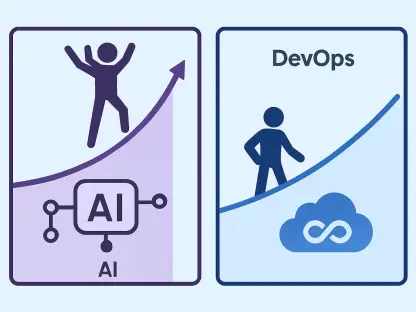In the ever-evolving landscape of infrastructure management, Terraform remains a pivotal tool in redefining how resources are provisioned and maintained. With the inherent flexibility that comes with defining infrastructure as code through the HashiCorp Configuration Language (HCL), one recurring challenge practitioners encounter is the need to convert lists into strings. This necessity is driven by configurations that require single string formats, whether for resource names, metadata, or as labels within cloud ecosystems. Understanding how to effectively perform these conversions is crucial in ensuring that Terraform configurations are both functional and robust.
Techniques for List-to-String Conversion
Leveraging the join() Function for Effective Concatenation
At the heart of Terraform’s list-to-string conversion capabilities lies the join() function. This function is indispensable for unifying elements of a list into a single string by specifying a delimiter. Often exemplified as join(", ", var.list_variable), it effortlessly merges list items separated by commas and spaces to create clear and structured outputs. This utility is particularly beneficial when setting up resource names or assembling tags for cloud resources, as it guarantees consistency and readability across configurations. For instance, transforming a list of environment tags — “dev,” “staging,” “prod”— into a coherent string exemplifies join()‘s ability to deliver consolidated results.
Beyond basic concatenation, the join() function proves invaluable in streamlining command-line operations. Consider the scenario where a single command needs to represent an array of commands; employing join() to concatenate with “&&” can effortlessly unify these into a single shell alias. By doing so, it simplifies operational workflows and enhances the overall efficiency of managing environments. In situations demanding articulate descriptions for security rules, join() is again the preferred choice to generate dynamic yet coherent text descriptions. By converting a list of permissible ports into detailed textual summaries, it enhances clarity and ensures comprehensive documentation.
Exploring format() and jsonencode() for Specialized Use Cases
While join() serves as the cornerstone for most conversions, scenarios arise where more specialized outputs are desired, and this is where format() and jsonencode() play significant roles. The format() function is specifically designed for custom output structuring, enabling users to combine with join() for tailored results. This dual approach is especially useful when crafting visually distinctive outputs, such as formatted port descriptors, where clarity in the display of information is paramount. For example, adapting a sequential port list into a formatted string can greatly enhance the legibility of configuration outputs.
In contexts requiring integration with APIs or modules reliant on JSON inputs, jsonencode() becomes indispensable. This function converts lists into JSON-formatted strings, ensuring structural integrity and preserving the essential array format. This is particularly beneficial for interfacing with systems where JSON is the standard input protocol, allowing for smooth data transfer and processing without compromising the data’s original structure. Together, all these functions contribute to a more flexible and adaptable Terraform environment, capable of handling diverse input and output scenarios efficiently.
Broader Impacts of List-to-String Conversions
Streamlining Naming Conventions and Tag Consistency
Analyzing Terraform’s approach to converting lists into strings uncovers broader trends that impact overall infrastructure management. A significant area of focus is the enhancement of naming conventions, where automated mechanisms integrate evolving parameters into coherent string formats for resources. This ensures that deployment identifications and environmental variables are consistently reflected across all stages of resource management. The modularity and automation achieved through these techniques also simplify long-term maintenance and scalability, making Terraform setups more sustainable.
Tag creation and management is another avenue where list-to-string conversions demonstrate their efficacy. Lists are transformed into singular strings for cloud resource tagging, aligning with standardized provider schemas. This is critical not only for operational visibility but also for auditing purposes, where standardized tagging facilitates inventory assessments and ensures compliance. By embedding these practices into the core of infrastructure configurations, organizations can achieve greater transparency and control over their cloud environments, ultimately enhancing their ability to monitor and optimize resource usage.
Enhancing Clarity in Security Configurations and User Data Scripts
A pivotal aspect of converting lists to strings involves the articulation of security configurations. This ensures that descriptions derived from lists — such as port numbers or configuration details — are communicated clearly, bolstering comprehension among DevOps teams and stakeholders. By transforming complex configuration specifics into intelligible textual representations, it becomes easier to manage and troubleshoot potential issues promptly, simplifying the task for operators without requiring them to delve into intricate code logic or documentation.
The effectiveness of these conversions extends to the realm of user data scripts in EC2 instances, where accurate interpretation of commands and configuration variables is paramount. By converting lists to strings, Terraform-generated data seamlessly integrates into operational scripts, ensuring that the desired outcomes are achieved without errors. This level of integration solidifies Terraform’s reputation as a tool capable of delivering not only functional infrastructure but also facilitating the efficient execution of operational tasks, thereby underscoring the necessity of mastering these conversion techniques.
Conclusion: Toward Optimized Infrastructure Management
In today’s rapidly changing world of infrastructure management, Terraform stands out as a crucial tool, revolutionizing the provisioning and maintenance of resources. Thanks to HashiCorp’s Configuration Language (HCL), Terraform allows for defining infrastructure as code. However, one persistent challenge for users is the need to transform lists into singular string formats. This transformation is often necessary for configuration aspects such as resource names, metadata, or cloud ecosystem labels, which require single string formats to function properly. Mastering these conversions is essential for ensuring that Terraform setups are effective and resilient. As infrastructure scales and customer requirements become more demanding, the ability to seamlessly convert lists to strings isn’t just a coding skill; it’s a vital part of maintaining operational excellence. Understanding this aspect of Terraform empowers developers to create configurations that not only meet technical requirements but also contribute toward achieving broader organizational goals.









